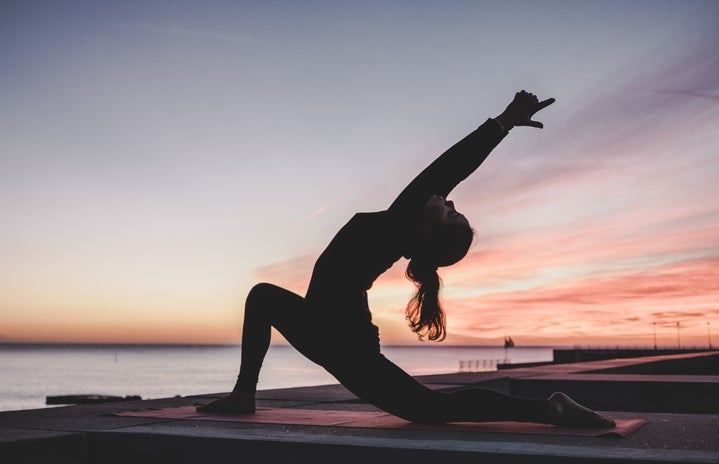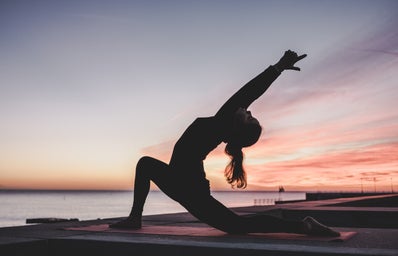Yoga is great for improving many things like relaxation, health and concentration. It’s popularity has also increased significantly in recent years. According to a survey by Yoga Alliance and Yoga Journal, the number of Americans who practice yoga has increased by 50 percent from 2012 to 2016 to over 36 million yogis. That is a significant increase in people practicing the ancient art of Yoga.
I currently practice yoga here at the University of Florida. I’m taking a World Dance and Intercultural Performance class taught by adjunct lecturer Angela Difiore. While I have personally practiced yoga for years now, I decided to ask Angela what poses she recommends for students who need to relax and de-stress. Here are five poses we recommend if you’re looking to relax your mind, body and spirit.
1. Child’s Pose (Balasana)
The first pose she recommends is Child’s Pose, or Balasana in sanskrit. We use Child’s Pose in class to regroup or relax in between strenuous asana poses, which translates to “comfortable seat.” Child’s Pose is great at relieving tension in the back, neck and shoulders, as well as easing symptoms of anxiety.
I’ve personally used Child’s Pose in my personal practices outside of class to ease my anxiety. If you’re feeling stressed and overwhelmed, it’s a great way to recuperate for as long as you need, and then get back to what you need to accomplish. Child’s Pose promotes purposeful breathing, which in turn helps to calm the nervous system during a panic attack or feelings of anxiety.
Whether you’re stressed about exams, your daily life or nothing in particular, take the time to try Child’s Pose to ease your nerves.
2. Sukhasana (Easy Pose)
As the English translation suggests, this next yoga pose is very easy to do. Sukhasana, otherwise known as Easy Pose, is a posture used for meditation and breathing exercises (Pranayama). Sukhasana strengthens the back and stretches the hips and ankles. The upright seated position also helps with spine alignment, which helps reduce stress and anxiety. This pose also helps to open up the hips, groin and outer thigh muscles.
Sitting still in this pose with either your eyes closed or fixated on a non-moving object and focusing on your breathing helps to calm the mind and the body. This pose is perfect if you can’t hit the mat as well. For instance, if you’re studying in the library and suddenly feel anxious about all your responsibilities, you can use Sukhasana to relax and allow your body to return to its normal state. Just sit up straight, cross your legs on the chair, close your eyes and focus on your breath. There are many variations of Sukhasana, so I suggest trying them all out and finding the pose that’s most comfortable for you.
Angela suggests using a blanket, meditation pillow or bolster when sitting in Sukhasana. Using a timer when doing a quick meditation helps to eliminate interruptions, as long as you are in a controlled environment. Meditating in the library makes it difficult to completely eliminate interruptions, but meditating in your room allows for complete silence. She also recommends turning off your phone and all other electronic devices to focus on yourself and your breathing.
3. Legs Up the Wall Pose (Viparita Karani)
This next pose requires you to be near a wall, so I recommend finding a place that’s quiet where you feel comfortable and relaxed. Legs Up the Wall Pose has many health benefits. It’s a great way to alleviate lower back pain, relieve discomfort from arthritis, menstrual cramps, reduce anxiety and lower high blood pressure. So basically, just laying down with your legs resting up against a wall is great for your health. Sign me up!
We also use this pose in our yoga practice. It’s very simple and very calming. Remaining in this pose for 10 minutes (or as long as you’d like to) with your eyes closed and focus on your breath helps stop your mind from wandering. For those with anxiety like me, it can be difficult to ignore all the thoughts that pop up in your mind. By focusing on only your breath, you can reduce distractions and as a result, relax your body and mind.
4. Tree Pose (Vrikasana)
Tree Pose is a little more difficult to perform compared to the previous poses because it requires complete concentration. Implementing Tree Pose into your de-stressing routine helps promote concentration, focus and awareness. It helps take your mind off of your stress and onto balancing your body.
You don’t necessarily need to rest your foot on your upper thigh to perform tree pose. Like many other yoga poses, there are variations of Tree Pose that allow you to ease into it if you’re a beginner. You can place your foot on your leg just below your knee if you can’t balance with your foot on your upper thigh.
There are also variations regarding your hands and arms in Tree Pose. You can press your hands together and hold them at “heart center”, otherwise known as “prayer hands”, or you can hold your arms straight up high, and cast your gaze above you or in front of you. Just make sure you choose a non-moving object so that you can focus completely on it and balance.
5. Simple Breathing Exercises
Angela also recommends doing simple breathing exercises. She believes that even if you only have 5-10 minutes, you can benefit from taking the time to do a simple breathing exercise or meditation.
Start by noticing your normal breathing pattern. Is it jagged? Smooth? Notice how your breath naturally feels. Focus on either the rising and falling of your chest as you breathe or the air entering and escaping your nose. Then, count from 1to 4 on the inhale and the exhale to make your breath equal. Then, when you feel relaxed, return to your individual breathing pattern.
This technique can be combined with Sukhasana, or it can be done while sitting upright in a chair. This is another yoga technique that can be performed anywhere without the use of a mat.
Another breathing technique that helps reduce stress is the Ujjayi Breath. It releases feelings of irritation and frustration, and helps calm the mind and body. There are many health benefits of practicing Ujjayi Breath, but a few include relieving tension, increasing oxygen in the blood and regulating blood pressure. To perform Ujjayi Breath, close your lips and breathe through your nose. Inhale through your nose a little more deeply than normal, and then exhale slowly through your nose. When you exhale, make sure you’re constricting the muscles in the back of your throat.
For further instruction on the Ujjayi Breath, watch the video below.
Anyone can practice yoga, as long as you’re determined and focused. If your particular goal is to de-stress by doing the yoga poses I mentioned, make sure you’re using proper alignment to prevent injury during your practice. I recommend looking up further instruction videos on YouTube to ensure that you’re knowledgeable on proper alignment and breathing to make sure you’re getting the most out of your practice. I hope you have fun on your yoga journey! Whether you’re an expert yogi or this is your first time doing yoga, I wish you a stress-free practice.
Thank you to Angela Difiore for her recommendations and for being an amazing yoga instructor.

